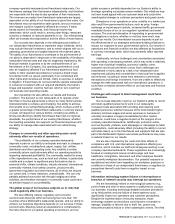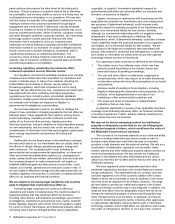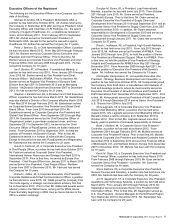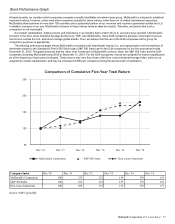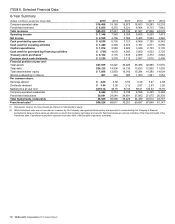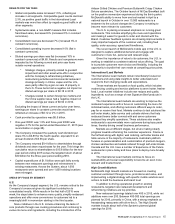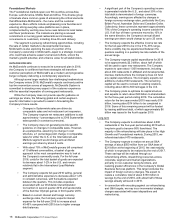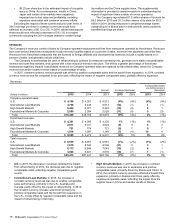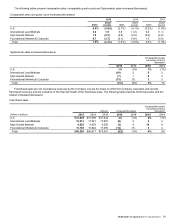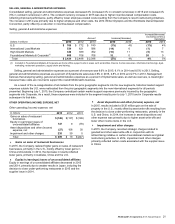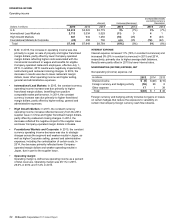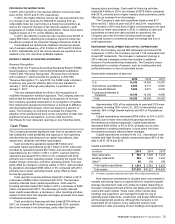McDonalds 2015 Annual Report Download - page 17
Download and view the complete annual report
Please find page 17 of the 2015 McDonalds annual report below. You can navigate through the pages in the report by either clicking on the pages listed below, or by using the keyword search tool below to find specific information within the annual report.
McDonald's Corporation 2015 Annual Report 15
RESULTS FOR THE YEAR:
• Global comparable sales increased 1.5%, reflecting an
increase in all segments. Comparable guest counts declined
2.3%, as positive guest traffic in the International Lead
markets was more than offset by negative guest traffic in all
other segments.
Systemwide sales, a non-GAAP measure that includes
franchised sales, decreased 6% (increased 3% in constant
currencies).
Consolidated revenues decreased 7% (increased 3% in
constant currencies).
Consolidated operating income decreased 10% (flat in
constant currencies).
Diluted earnings per share was flat (increased 10% in
constant currencies) at $4.80. Results and comparisons were
impacted by the following current and prior year items
outside normal operations:
* Strategic charges, primarily related to goodwill
impairment and other asset write-offs in conjunction
with the Company's refranchising initiatives,
restructuring activities and incremental restaurant
closings primarily in China, Japan and the U.S.,
were partly offset by a gain on sale of property in
the U.S. These items had a negative net impact on
diluted earnings per share of $0.18 in 2015.
* Charges related to certain foreign tax matters and
the China supplier issue had a negative impact on
diluted earnings per share of $0.54 in 2014.
Excluding the impact of these current and prior year items,
earnings per share in constant currencies would have
reflected an increase of $0.12 or 2% in 2015.
Cash provided by operations was $6.5 billion.
One-year ROIIC was 1.5% and three-year ROIIC was
negative 3.7% for the period ended December 31, 2015 (see
reconciliation on page 28).
The Company increased the quarterly cash dividend per
share 5% to $0.89 for the fourth quarter, equivalent to an
annual dividend of $3.56 per share.
The Company returned $9.4 billion to shareholders through
dividends and share repurchases for the year. This brings the
cumulative return to shareholders to $15.8 billion for the two-
year period ending 2015 versus the targeted return of about
$30 billion for the three-year period ending 2016.
Capital expenditures of $1.8 billion were split fairly evenly
between new restaurant openings and reinvestment in
existing restaurants. Across the System, about 1,000
restaurants were opened and over 1,000 existing locations
were reimaged.
AREAS OF FOCUS BY SEGMENT
U.S.
As the Company's largest segment, the U.S. remains critical to the
Company's turnaround given its significant contribution to
consolidated results. While results in the first half of 2015 were
weak, the steps taken to enhance menu quality, simplify restaurant
operations and offer more convenience to customers led to a
meaningful shift in momentum starting in the third quarter.
Menu initiatives in the U.S. include enhancing the taste of
core products through new cooking procedures and continuing to
evolve its menu and ingredients, including the introduction of the
Artisan Grilled Chicken and Premium Buttermilk Crispy Chicken
Deluxe sandwiches. The October launch of All Day Breakfast built
on the positive momentum experienced during the third quarter.
McDonald’s ability to move from one test market in April to a
national launch in October in over 13,000 restaurants is a
testament to the cultural changes the Company is making to
become more relevant to customers.
The U.S. is placing a renewed emphasis on running great
restaurants. This includes simplifying the menu and operations
and making it easier for guests to order and interact with the
Brand. Customer feedback systems are showing improvements in
many important aspects of the customer visit, including food
quality, order accuracy, speed and friendliness.
The recent launch of McDonald’s mobile app in the U.S. is
designed to capture additional demand and engage with
customers in more fun, personal and relevant ways.
Given the importance of value to its customers, the U.S. is
working to establish a consistent national value offering. The goal
is to provide customers more choice and flexibility, including the
opportunity to bundle their own meals at compelling price points.
International Lead Markets
The International Lead markets remain relentlessly focused on
customers and using data insights to better understand and
respond to their changing needs and expectations.
These markets are focused on food quality, which includes
modernizing cooking and service platforms to serve hotter, fresher
food. Local market initiatives include new recipes and quality
ingredients, such as a range of new Signature Beef products in
the U.K.
The International Lead markets are working to improve the
restaurant experience with a focus on customizing the menu for
individual tastes, and offering customers different ways to order,
pay for or receive their food. Markets continue to test solutions like
self-order kiosks, table service and curbside delivery that help
restaurant teams better connect with and serve customers
because they simplify operations. These solutions also enable
restaurants to accommodate more customers during busy peak
times, thereby driving overall business performance.
Markets are at different stages, but all are making steady
progress towards enhancing the customer experience. France is
the furthest along with digital, web ordering, self-order kiosks and
table service in the majority of restaurants. Australia's platform
focuses on personalization and customization of premium burgers,
chicken sandwiches and salads ordered through self-order kiosks.
Canada and the U.K. have a number of Experience of the Future
restaurants in place today and have plans to deploy more broadly
in 2016.
The International Lead markets continue to focus on
sustainability and social responsibility to become an even more
relevant and trusted brand.
High Growth Markets
McDonald's High Growth markets are focused on creating
customer excitement through menu, promotions and value, and
implementing a digital strategy with specific mobile solutions and
actions to build the business and brand trust.
In addition to driving operational growth in existing
restaurants, targeted new restaurant development and
refranchising initiatives are top priorities.
New restaurant openings totaled over 400 in 2015, while net
additions were over 200. Between 400-500 total openings are
planned for 2016, primarily in China, with a strong emphasis on
freestanding restaurants with drive-thru’s. The High Growth
markets include about half of the System’s planned global
openings for 2016.


